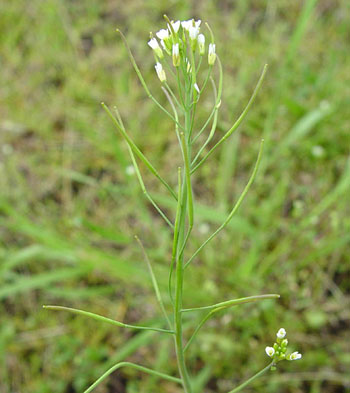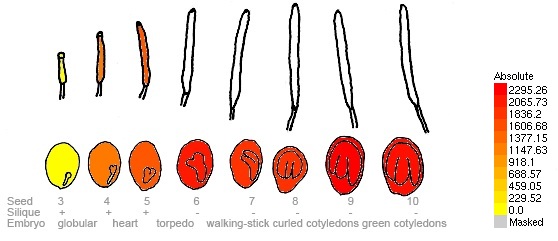Team:Bielefeld-Germany/Project/Background/thaliana
From 2012.igem.org
(→Arabidopsis thaliana) |
|||
| Line 20: | Line 20: | ||
The Arabidopsis Information Resource (TAIR), www.arabidopsis.org/aboutarabidopsis.html, on www.arabidopsis.org, Oct 24, 2000 | The Arabidopsis Information Resource (TAIR), www.arabidopsis.org/aboutarabidopsis.html, on www.arabidopsis.org, Oct 24, 2000 | ||
Winter ''et al.'' (2007). Arabidopsis eFP Browser at bar.utoronto.ca. PLosOne 2(8): e718. | Winter ''et al.'' (2007). Arabidopsis eFP Browser at bar.utoronto.ca. PLosOne 2(8): e718. | ||
| + | |||
| + | ==''Escherichia coli''== | ||
| + | |||
| + | Another laccase, which catched our attention is the enzyme [http://www.ncbi.nlm.nih.gov/protein/85674340 CueO] from ''Escherichia coli''. The bacterium naturally occurs in human and animal intestine. In laboratory it’s a model organism and the most widely used organism in molecular genetics. So the about 1-6 µm long all rounder is even more promising and has a laccase with a high potential for our approaches. It is described that CueO is able to oxidize different PAHs (Zeng, Lin ''et al.'', 2011). Our aim is to produce and characterize this laccase with regard to the plan to develop a biological filter using immobilized laccases. Therefore we isolated the laccase CueO from ''E. coli DE''(BL21) out of genomic DNA. For further information about the characterization of CueO [https://2012.igem.org/Team:Bielefeld-Germany/Results/Summary look here]. | ||
| + | |||
| + | Zeng, J., X. Lin, ''et al.'' (2011). "Oxidation of polycyclic aromatic hydrocarbons by the bacterial laccase CueO from ''E. coli''." Appl Microbiol Biotechnol 89(6): 1841-1849. | ||
{{Team:Bielefeld/Sponsoren}} | {{Team:Bielefeld/Sponsoren}} | ||
Revision as of 10:11, 22 September 2012
Arabidopsis thaliana

Arabidopsis thaliana (A. thaliana), or commonly known as thale cress, is a small flowering plant which has been established as a model organism. We have chosen this little plant as a representative for higher eukaryotes and not only because there is a lot of research going on at Bielefeld University with this tiny little weed. A thaliana has a small genome with 125 Mb total and was sequenced completely in the year 2000. Besides the good annotation of genes there is also a large number of mutant lines available. The research on A. thaliana is progressing fast and researchers from all around the world are working with this model organism because of its rapid life cycle of 6 weeks and its easy cultivation even at restricted places, just to name a few examples. The Arabidopsis community is therefore huge and progress in understanding the cellular and molecular biology of this flowering plant is documented well and available.
For our project we were interested in the laccase(s) of Arabidopsis. We did some research at TAIR and found 22 laccases or laccase-like genes. Stunned by the amount of laccase genes we decided to concentrate on just one which does not encode a laccase-like protein. We have chosen gene AT5G48100.1 and investigated further. Our next stop was at the eFP Browser to see where our chosen laccase is expressed. We found out, that it is expressed in the seeds and therefore available in the siliques, as you can see in here:
With this bioinformatic research and the following laboratory work we try to get in contact with a laccase from a higher eukaryote.
References
The Arabidopsis Information Resource (TAIR), www.arabidopsis.org/aboutarabidopsis.html, on www.arabidopsis.org, Oct 24, 2000 Winter et al. (2007). Arabidopsis eFP Browser at bar.utoronto.ca. PLosOne 2(8): e718.
Escherichia coli
Another laccase, which catched our attention is the enzyme CueO from Escherichia coli. The bacterium naturally occurs in human and animal intestine. In laboratory it’s a model organism and the most widely used organism in molecular genetics. So the about 1-6 µm long all rounder is even more promising and has a laccase with a high potential for our approaches. It is described that CueO is able to oxidize different PAHs (Zeng, Lin et al., 2011). Our aim is to produce and characterize this laccase with regard to the plan to develop a biological filter using immobilized laccases. Therefore we isolated the laccase CueO from E. coli DE(BL21) out of genomic DNA. For further information about the characterization of CueO look here.
Zeng, J., X. Lin, et al. (2011). "Oxidation of polycyclic aromatic hydrocarbons by the bacterial laccase CueO from E. coli." Appl Microbiol Biotechnol 89(6): 1841-1849.
| 55px | | | | | | | | | | |
 "
"






